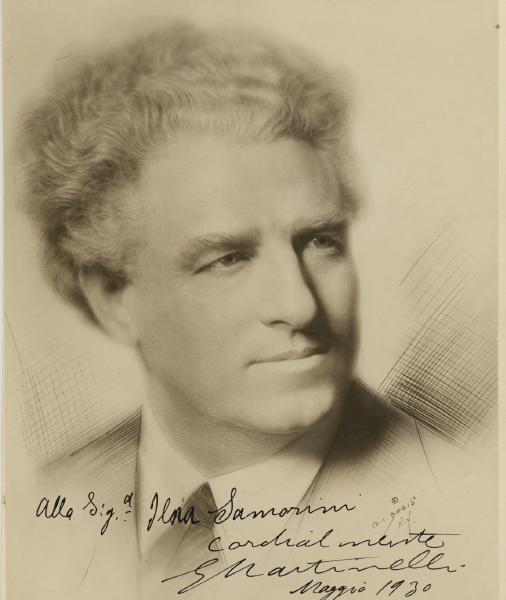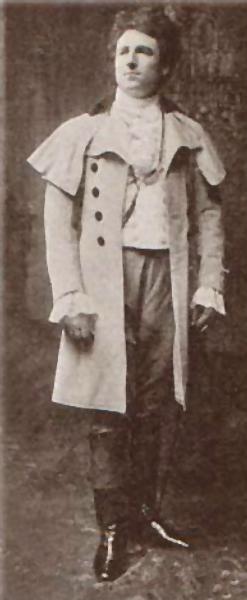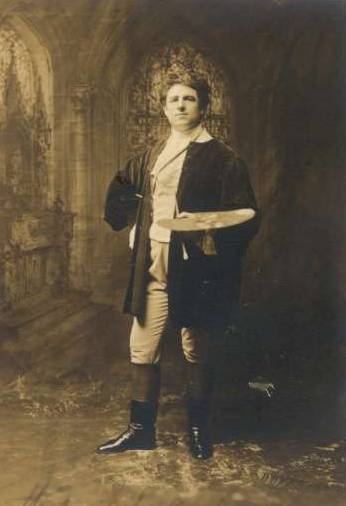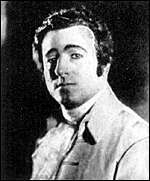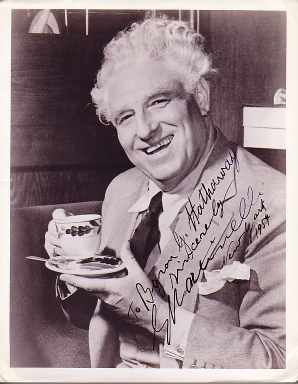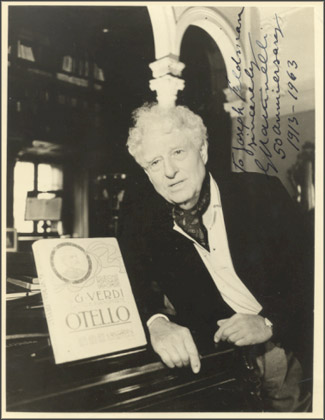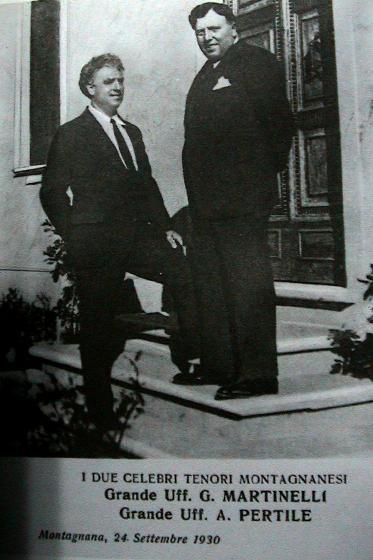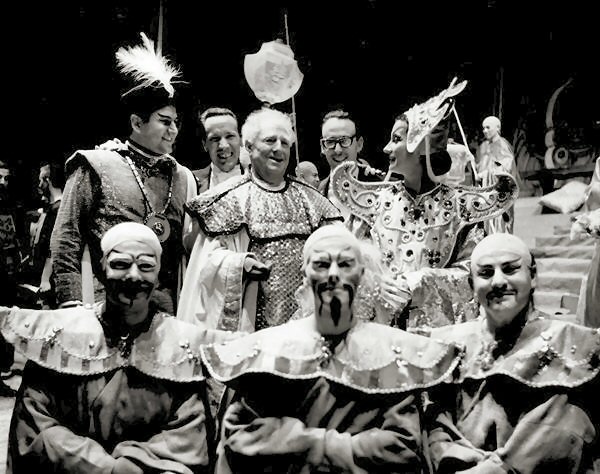Giovanni Martinelli
I wish to thank Thomas Silverbörg for the pictures as Cavaradossi.
Giovanni Martinelli was born on the same small street as, and merely 18 days earlier than Aureliano Pertile. As a teenager, he started playing the clarinet in Montagnana's municipal band, and so during military
service, he was assigned to the marching band. It was the conductor of that band who discovered Martinelli's voice, and urged him to
have it trained.
After being released from the army, Martinelli sang – still as an amateur – his first stage role (the Messenger in Aida
"at home" in Montagnana), and he auditioned in Milano, without having studied; the impresario of the Teatro Dal Verme brokered an
exclusive contract for the young singer, with a very well-known artist management that would even pay for his vocal studies. His debuts
took then place at the Dal Verme, first in concert then in opera, both in December 1910.
In 1911, Martinelli already sang at the Teatro Costanzi in Rome, the San Carlo in Naples and the Grande in Brescia; in 1912, at the
Carlo Felice in Genova, in Monte Carlo, at Covent Garden in London, and at La Scala in Milano, with major success in all those places.
His Rodolfo at La Scala (where he would never return) was heard by Met manager Giulio Gatti-Casazza, who hired Martinelli instantly for
his theater.
Martinelli spent 1913 mostly at Covent Garden and La Monnaie in Brussels, as well as in Paris (Théâtre des
Champs-Élysées), and made his Met debut on 20 November, again as Rodolfo. Soon, he became one of the Met's foremost star
singers – 926 performances and concerts until March 1946!
He made a lot of guest appearances elsewhere, too, however. Above all at Covent Garden (more than 90 performances from 1912 to 1937),
but also at the Colón in Buenos Aires, in Rio de Janeiro, Monte Carlo, Rome, at the Teatro Dal Verme, in Paris, San Francisco,
Chicago, St. Louis, Cincinnati or Philadelphia. He did not sing the two world premieres for which Arturo Toscanini wanted him at La
Scala: Boito's Nerone (1921), and Turandot (1926) – Met director Gatti-Casazza was Toscanini's sworn enemy, and so
Martinelli had to refrain from returning to La Scala (Toscanini's reign).
Martinelli's voice was clarion, but apart from the first few years, it lacked flexibility, vibrato, colors, nuances; by the
mid-1930s, his stiff, inalterable "organ-pipe" tones were definitely an acquired taste. But his vocal condition was remarkably robust.
He officially retired only in 1950, at age 65, but even then, he still sang occasionally in public, the last time in Seattle in 1967, as
Altoum.
Reference 1: Treccani, Dizionario biografico degli italiani, vol. 71, Rome 2008; reference 2: Kutsch & Riemens; reference 3
I wish to thank Daniele Godor for the recording (Tristan und Isolde). I wish to thank Joseph Shore for the recording (Aida). I wish to thank Thomas Silverbörg for the recordings (Iris, Samson). Aida (Messenger) – Montagnana, Sociale, 12 September 1908 Ernani – Milano, Dal Verme, 29 December 1910 Ruy Blas – Milano, Dal Verme, 15 February 1911 Un ballo in maschera – Ancona, delle Muse, 8 April,1911 La fanciulla del West – Roma, Costanzi, 24 June 1911 Aida – Torino, Vittorio Emanuele, 10 October 1911 Tosca – London, Covent Garden, 22 April 1912 I gioielli della Madonna – London, Covent Garden, 30 May 1912 Manon Lescaut – London, Covent Garden, 19 June 1912 Melenis (by Zandonai) – Milano, Dal Verme, 13 November 1912 (world premiere) Yato (by Marguerite de Pachmann Labori) – Monte Carlo, 28 March 1913 (world premiere) Madama Butterfly – London, Covent Garden, 11 June 1913 La Dubarry – London, Covent Garden, 3 July 1913 Pagliacci – London, Covent Garden, 19 July 1913 La bohème – Baltimore, Lyric, 15 November 1913 Il trovatore – Monte Carlo, 17 February 1914 I mori di Valenza (by Ponchielli) – Monte Carlo, 17 March 1914 (world premiere) Francesca da Rimini – London, Covent Garden, 16 July 1914 Madame Sans-Gêne – New York, Met, 25 January 1915 (world premiere) Carmen – New York, Met, 18 March 1915 Les huguenots – Atlanta, Auditorium, 26 April 1915 Goyescas – New York, Met, 28 January 1916 Lucia di Lammermoor – New York, Met, 31 January 1916 Faust – New York, Met, 17 November 1917 L'amore dei tre re – New York, Met, 6 April 1918 Oberon – New York, Met, 28 December 1919 Evgenij Onegin – New York, Met, 24 March 1920 Zazà – New York, Met, 17 April 1920 Don Carlo – New York, Met, 23 December 1920 Monna Vanna – Buenos Aires, Colón, 30 July 1921 La forza del destino – New York, Met, 31 March 1922 Samson et Dalila – New York, Met, 6 April 1922 Guillaume Tell – New York, Met, 5 January 1923 Fedora – New York, Met, 8 December 1923 Lakmé – Chicago, Ravinia, 14 August 1924 La Juive – New York, Met, 12 December 1924 Rigoletto – Chicago, Ravinia, 1 August 1926 Andrea Chénier – Chicago, Ravinia, 10 August 1926 Le prophète – New York, Met, 31 December 1927 La campana sommersa (by Respighi) – New York, Met, 24 November 1928 Simon Boccanegra – New York, Met, 28 January 1932 La Gioconda – New York, Met, 23 April 1932 L'Africaine – New York, Met, 28 December 1933 Otello – San Francisco, War Memorial, 20 November 1936 Norma – New York, Met, 20 February 1937 Turandot – London, Covent Garden, 30 April 1937 Tristan und Isolde – Chicago, 24 November 1939 Turandot (Emperor) – Seattle, Opera House, 31 January 1967 Reference: Paolo Padoan & Maurizio Tiberi, Giovanni Martinelli, un leone al Metropolitan, TimaClub 2007 Reference: The Record Collector, volume 25, nos. 7/8/9, October 1979 |
